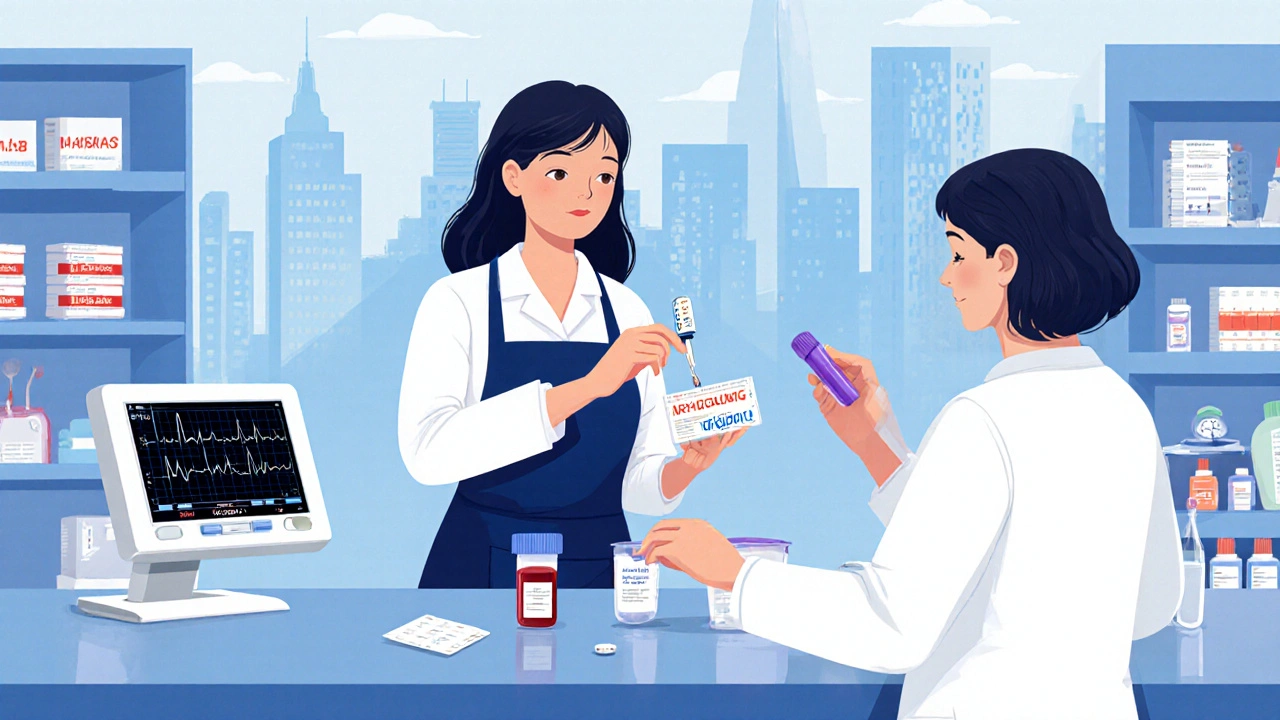Lanoxin (Digoxin) vs Alternative Heart Medications: Which Is Right for You

Digoxin Suitability Checker
This tool helps determine whether Digoxin might be suitable for a patient based on key medical factors.
TL;DR
- Lanoxin (digoxin) is useful for specific heart‑failure and atrial‑fibrillation cases but has a narrow therapeutic window.
- Beta‑blockers (metoprolol, carvedilol) and ACE‑inhibitors (lisinopril) are first‑line for most heart‑failure patients.
- Spironolactone and ivabradine work well when you need extra symptom control without raising heart rate.
- Amiodarone is a powerful rhythm‑control drug but carries serious long‑term side‑effects.
- Choosing the right drug depends on kidney function, heart rate, other meds, and how closely you can be monitored.
When your doctor mentions Lanoxin, you’re hearing the brand name for Digoxin is a cardiac glycoside that strengthens heart contractions and slows the electrical signals that cause rapid beating. It’s been around for over two centuries, but modern guidelines reserve it for niche situations because the margin between a helpful dose and a toxic one is slim. If you’re hunting for alternatives, you’ll want to weigh efficacy, safety, dosing convenience, and how well the drug fits your overall health picture.
How Digoxin Works - The Science in Simple Terms
Digoxin binds to the Na⁺/K⁺‑ATPase pump on heart cells, which leads to a slight rise in intracellular calcium. More calcium means stronger beats, and the drug also nudges the vagus nerve to slow the heart’s electrical conduction. The result is a slower, more efficient pump - a classic "positive inotrope" plus "negative chronotrope".
When Doctors Actually Prescribe Lanoxin
Guidelines keep digoxin for two main groups:
- Patients with heart failure who remain symptomatic despite ACE inhibitors, beta‑blockers, and diuretics.
- Individuals with atrial fibrillation who need rate control and cannot tolerate other agents.
It’s not a go‑to for everyone because newer drugs are safer and easier to dose.
Key Risks & How to Monitor
Because the therapeutic range sits between 0.5-2.0ng/mL, blood‑level checks are mandatory. Too high, and you might see nausea, visual halos, or a dangerously slow heart rate. Kidney function is crucial - digoxin is cleared renally, so a drop in eGFR means you need a lower dose.
Alternative Medications - Quick Snapshot
Below are the most common alternatives, each with a brief definition.
- Metoprolol is a beta‑blocker that lowers heart rate and reduces oxygen demand, widely used for heart failure and arrhythmias.
- Carvedilol combines beta‑blockade with mild alpha‑blockade, offering added blood‑pressure control for heart‑failure patients.
- Lisinopril is an ACE inhibitor that relaxes blood vessels, lowering pressure and helping the failing heart pump more effectively.
- Spironolactone is a potassium‑sparing diuretic that blocks aldosterone, useful for reducing fluid overload in advanced heart failure.
- Ivabradine selectively inhibits the funny current (If) in the sinus node, slowing heart rate without lowering blood pressure.
- Amiodarone is a powerful anti‑arrhythmic that stabilises heart rhythm but can affect thyroid, lungs, and liver over time.

Side‑by‑Side Comparison
| Drug | Mechanism | Typical Indication | Usual Dose Range | Monitoring Needed | Major Side Effects |
|---|---|---|---|---|---|
| Lanoxin (Digoxin) | Inhibits Na⁺/K⁺‑ATPase → ↑ intracellular Ca²⁺ | Heart failure (symptomatic), A‑fib rate control | 0.125-0.25mg daily (adjust for kidney) | Serum level, renal function, electrolytes | Nausea, visual disturbances, bradycardia, arrhythmia |
| Metoprolol | β1‑adrenergic blockade | Heart failure, hypertension, A‑fib | 25-200mg daily (split doses) | Heart rate, blood pressure, signs of worsening HF | Fatigue, cold extremities, bronchospasm (asthma) |
| Carvedilol | β‑blockade + α1‑blockade | Heart failure, post‑MI remodeling | 3.125-25mg twice daily | Blood pressure, weight, heart rate | Dizziness, weight gain, hypoglycemia (diabetics) |
| Lisinopril | ACE inhibition → ↓ Ang II | Hypertension, heart‑failure, post‑MI | 5-40mg daily | Kidney function, potassium, cough | Cough, hyperkalemia, angio‑edema |
| Spironolactone | Aldosterone antagonist | Advanced HF, resistant hypertension | 25-100mg daily | Potassium, renal function | Hyperkalemia, gynecomastia, menstrual changes |
| Ivabradine | If current inhibition → ↓ heart rate | HF with HR>70 bpm, chronic angina | 5-7.5mg BID | Heart rate, visual phosphenes | Bradycardia, luminous phenomena, atrial fibrillation |
| Amiodarone | Multi‑channel blocker (K⁺, Na⁺, Ca²⁺) | Refractory ventricular or atrial arrhythmias | 200mg daily (maintenance) | Liver enzymes, thyroid, pulmonary function | Thyroid dysfunction, lung toxicity, photosensitivity |
When to Stick With Digoxin
Even with newer drugs, digoxin still shines in a few scenarios:
- Highly symptomatic HF where you need extra inotropic support.
- Rate control in A‑fib when beta‑blockers cause low blood pressure or aren’t tolerated.
- Renal‑friendly dosing - low‑dose digoxin can be safe even when eGFR drops, provided you monitor levels.
If you fit one of these boxes and you can get regular blood tests, digoxin might remain the right choice.
When an Alternative Beats Digoxin
Consider swapping if you encounter any of these red flags:
- Persistent nausea, vomiting, or visual halos - classic digoxin toxicity signs.
- Low potassium or high magnesium - electrolytes that predispose to arrhythmias.
- Unable to attend routine serum‑level checks (e.g., living far from a lab).
- Concurrent drugs like amiodarone or quinidine that raise digoxin levels.
In those cases, a beta‑blocker or ACE inhibitor often provides similar symptom relief with less monitoring hassle.
Practical Tips for Taking Digoxin Safely
- Take it at the same time each day - consistency helps keep levels stable.
- Avoid high‑potassium foods (e.g., banana excess) if you’re also on spironolactone - both raise potassium.
- Stay hydrated, but avoid massive fluid overload which can dilute serum levels.
- Inform every new prescriber that you’re on digoxin; many drugs (e.g., certain antibiotics) can interact.
Frequently Asked Questions
Can I take digoxin and a beta‑blocker together?
Yes, many clinicians combine a low‑dose beta‑blocker with digoxin to get both rate control and inotropic support. The key is close monitoring of heart rate and blood pressure.
How often should I get blood tests for digoxin?
Initially, check the serum level 6‑8hours after the first dose, then again after a week once you’re stable. After that, most patients do it every 3‑6 months, unless kidney function changes.
What should I do if I notice visual halos?
Visual halos are an early sign of toxicity. Call your doctor right away; they’ll likely order an urgent blood level and may hold the next dose.
Is digoxin safe for older adults?
It can be, but older adults usually have reduced kidney function, so the dose must be lowered and levels checked more often.
Why do some guidelines say digoxin is ‘optional’?
Because newer drugs (beta‑blockers, ACE inhibitors, ARNI) have proven mortality benefits with easier dosing. Digoxin still helps symptom relief, but it doesn’t improve survival the way those newer agents do.
Next Steps - How to Decide What’s Best for You
Grab a pen and run through this quick checklist:
- Do you have stable kidney function (eGFR>50mL/min)? If not, digoxin dose must be cut.
- Are you already on beta‑blockers or ACE inhibitors and tolerating them? If yes, you may not need digoxin.
- Can you get a serum level test every few months? If no, an alternative with less monitoring is safer.
- Do you experience side‑effects like nausea or visual changes? Switch to a different class.
If the answers point to “yes” for most, bring up digoxin with your clinician. If several are “no,” ask about starting a beta‑blocker, an ACE inhibitor, or a combination of spironolactone and ivabradine depending on your specific symptoms.
Remember, medication choice is a partnership. Share your lifestyle, lab results, and any concerns openly. The right drug - whether it’s Lanoxin, metoprolol, or something else - should fit your body, your routine, and your health goals.

Nitin Chauhan
September 28, 2025 AT 14:35Digoxin can still be useful if monitored properly.
Sarah Aderholdt
September 29, 2025 AT 04:28While newer agents dominate heart‑failure protocols, digoxin remains a niche option for patients who can’t tolerate beta‑blockers. Its inotropic boost can alleviate symptoms when other drugs fall short. Keep an eye on kidney function and serum levels to stay safe.
Phoebe Chico
September 29, 2025 AT 18:21Ah, the old Lanoxin – it’s like the vintage vinyl of cardiac meds, full of character but requiring a careful spin. If you’ve got the right lab support, it can keep that heart humming nicely. Just don’t let it turn into a toxic solo.
Larry Douglas
September 30, 2025 AT 08:15Digoxin’s mechanism of action involves inhibition of the Na⁺/K⁺‑ATPase pump which leads to an increase in intracellular calcium and thereby enhances myocardial contractility. This positive inotropic effect can be valuable in patients with advanced heart failure who remain symptomatic despite optimal guideline‑directed therapy. In addition to its inotropic properties digoxin also exerts a negative chronotropic effect by increasing vagal tone which helps control ventricular rate in atrial fibrillation. The therapeutic window of digoxin is narrow therefore regular monitoring of serum concentrations is essential to avoid toxicity. Toxic levels can manifest as gastrointestinal upset visual disturbances and potentially life‑threatening arrhythmias. Renal clearance is the primary route of elimination so dosing must be adjusted in patients with reduced eGFR. Studies have shown that digoxin does not confer a mortality benefit in the modern era when compared to beta‑blockers ACE inhibitors and ARNI therapy. Nevertheless it can improve quality of life by relieving dyspnea and fatigue in select individuals. Patient education regarding adherence timing is crucial because fluctuations in plasma levels can precipitate adverse events. Drug interactions are common; for instance amiodarone and certain antibiotics can raise digoxin concentrations. Electrolyte imbalances, particularly hypokalemia and hypermagnesemia, heighten the risk of arrhythmogenic toxicity. A baseline ECG is advisable before initiation to document heart rate and rhythm. Follow‑up labs should be obtained within a week of starting therapy and subsequently every three to six months. In practice clinicians often reserve digoxin for patients who are already on beta‑blockers ACE inhibitors and diuretics yet remain symptomatic. When used judiciously digoxin remains a useful tool in the heart‑failure armamentarium.
Ann Campanella
September 30, 2025 AT 22:08Honestly this article drags on way too long. The key points could've been summed up in a paragraph.
Desiree Tan
October 1, 2025 AT 12:01Great job breaking down the options! Keep pushing those patients to ask their doctors about the monitoring plan so they can stay on the right track.
Andrea Dunn
October 2, 2025 AT 01:55Looks like pharma wants us to forget about cheap old digoxin while pushing pricey new drugs 😊. Remember to question who benefits from the hype.
Erin Johnson
October 2, 2025 AT 15:48Oh sure, because everyone has a lab on speed‑dial these days. If you love waiting weeks for a blood draw, digoxin is your dream medication, right?
Rica J
October 3, 2025 AT 05:41i think u should check ur potassium before startin digoxin, else u might get nasty side effects.
Linda Stephenson
October 3, 2025 AT 19:35has anyone tried combining low‑dose digoxin with ivabradine? curious if that combo eases symptoms without extra lab work.
Sunthar Sinnathamby
October 4, 2025 AT 09:28I hear you, Sunthar. Managing heart failure can feel overwhelming, but tracking your meds and labs step by step really helps keep things under control.
Catherine Mihaljevic
October 4, 2025 AT 23:21Most guidelines overstate digoxin benefits ignore its risks.
Bernard Lingcod
October 5, 2025 AT 13:15While the data suggest limited mortality advantage, real‑world patients still report improved exercise tolerance with digoxin. It’s worth a trial if other therapies fall short.
Raghav Suri
October 6, 2025 AT 03:08Make sure you have a reliable lab nearby; without regular levels you’re gambling with a drug that has a razor‑thin safety margin.
Alfred Benton
October 6, 2025 AT 17:01It is evident that the prevailing medical narrative suppresses older therapeutics in favor of pharmaceutical profit motives, thereby depriving patients of cost‑effective alternatives.
Susan Cobb
October 7, 2025 AT 06:55In conclusion, the nuanced decision between digoxin and its modern counterparts demands a sophisticated understanding that most clinicians lack, resulting in suboptimal prescribing.